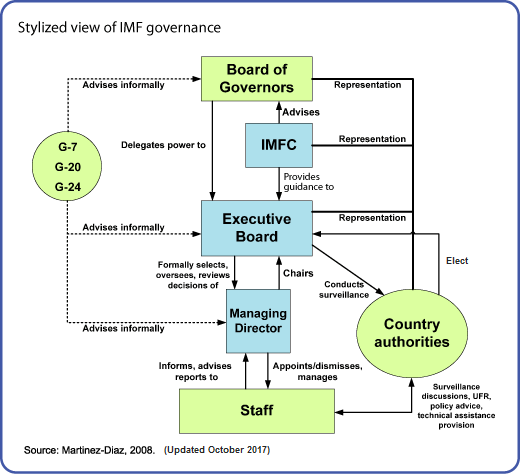Governance Structure
The IMF's mandate and governance have evolved along with changes in the global economy, allowing the organization to retain a central role within the international financial architecture. The diagram below provides a stylized view of the IMF's current governance structure.

Board of Governors
The Board of Governors is the highest decision-making body of the IMF. It consists of one governor and one alternate governor for each member country. The governor is appointed by the member country and is usually the minister of finance or the head of the central bank.
While the Board of Governors has delegated most of its powers to the IMF's Executive Board, it retains the right to approve quota increases, special drawing right (SDR) allocations, the admittance of new members, compulsory withdrawal of members, and amendments to the Articles of Agreement and By-Laws.
The Board of Governors also elects or appoints executive directors and is the ultimate arbiter on issues related to the interpretation of the IMF's Articles of Agreement. Voting by the Board of Governors usually takes place by mail-in ballot.
The Boards of Governors of the IMF and the World Bank Group normally meet once a year, during the IMF-World Bank Annual Meetings, to discuss the work of their respective institutions. The Meetings, which take place in September or October, have customarily been held in Washington for two consecutive years and in another member country in the third year.
The Annual Meetings usually include two days of plenary sessions, during which Governors consult with one another and present their countries' views on current issues in international economics and finance. During the Meetings, the Boards of Governors also make decisions on how current international monetary issues should be addressed and approve corresponding resolutions.
The Annual Meetings are chaired by a Governor of the World Bank and the IMF, with the chairmanship rotating among the membership each year. Every two years, at the time of the Annual Meetings, the Governors of the Bank and the Fund elect Executive Directors to their respective Executive Boards.
Ministerial Committees
The IMF Board of Governors is advised by two ministerial committees, the International Monetary and Financial Committee (IMFC) and the Development Committee.
The IMFC has 24 members, drawn from the pool of 191 governors. Its structure mirrors that of the Executive Board and its 24 constituencies. As such, the IMFC represents all the member countries of the Fund.
The IMFC meets twice a year, during the Spring and Annual Meetings. The Committee discusses matters of common concern affecting the global economy and also advises the IMF on the direction its work. At the end of the Meetings, the Committee issues a joint communiqué summarizing its views. These communiqués provide guidance for the IMF's work program during the six months leading up to the next Spring or Annual Meetings. There is no formal voting at the IMFC, which operates by consensus.
The Development Committee is a joint committee, tasked with advising the Boards of Governors of the IMF and the World Bank on issues related to economic development in emerging and developing countries. The committee has 24 members (usually ministers of finance or development). It represents the full membership of the IMF and the World Bank and mainly serves as a forum for building intergovernmental consensus on critical development issues.
The Executive Board
The IMF’s 24-member Executive Board conducts the daily business of the IMF and exercises the powers delegated to it by the Board of Governors, as well as those powers conferred on it by the Articles of Agreement. With the entry into force of the Board Reform Amendment on January 26, 2016, the all-elected Executive Board has been in place since the subsequent election took effect on November 1, 2016. Previously, the member countries holding the five largest quotas were each entitled to appoint an Executive Director, while 19 were elected by the remaining member countries.
The Board discusses all aspects of the Fund’s work, from the IMF staff's annual health checks of member countries' economies to policy issues relevant to the global economy. The Board normally makes decisions based on consensus, but sometimes formal votes are taken. The votes of each member equal the sum of its basic votes (equally distributed among all members) and quota-based votes. Therefore, a member’s quota determines its voting power. Following most formal meetings, the Board summarizes its views in a document known as a Summing Up. Informal meetings may also be held to discuss complex policy issues at a preliminary stage.
To view Executive Board documents, which are available in the public domain, visit the Executive Board Documents Collection via the IMF Archives Catalog. The Collection includes: agendas and minutes of Board meetings; policy papers; staff reports; reports on missions to member countries; and discussions of fiscal, monetary and economic policy issues.
Governance Reform
To be effective, the IMF must be seen as representing the interests of all its 191 member countries. For this reason, it is crucial that its governance structure reflect today’s world economy. In 2010, the IMF agreed wide-ranging governance reforms to reflect the increasing importance of emerging market countries. The reforms also ensure that smaller developing countries will retain their influence in the IMF.
- Governance Structure
- Country Representation
- Accountability
- Who we are
- Statutes and Decisions
- Evaluation and Audit
- Corporate Citizenship
- More Resources
